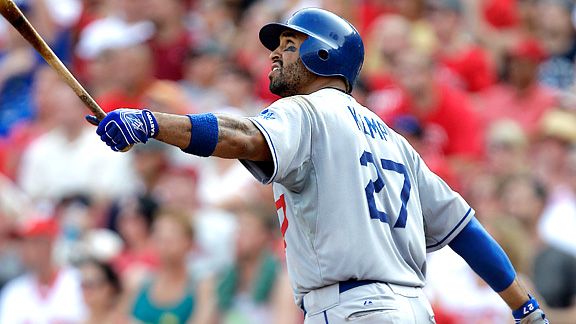The simplest form of baseball statistics is batting average. It’s been around since they invented the game. But since Bill James and the sabermetrics nerds of the world have really let their voice be heard, new and more complex stats have been invented and slowly integrated into the contemporary baseball rhetoric. Still, I’m ready for the more complex to be more readily available. My campaign starts with a stat that I thought up yesterday in an attempt to quantify what exactly speedy guys like Dee Gordon, Juan Pierre and Jose Reyes bring to a game that is lost in our obsession with how far a guy can hit the baseball. Admittedly, chicks dig the long ball, but not everyone can be Adam Dunn or Josh Hamilton.
The impetus for Slugging Percentage Plus was that a single or walk immediately followed by a steal of second base is basically like hitting a double. When there’s real speed guys out there (think Rickey Henderson or Mikey Perrone or Billy Hamilton), a walk turns into a triple rather quickly. With that, shouldn’t we quantify slugging percentage as (Total Bases + SB) per Plate Appearance? Taking it one step further, the Moneyball approach that a walk is as good as a single makes the Slugging Percentage Plus equation
SPP = ((TB + SB + Walks + HBP) / (PA))
As was outlined beautifully over at The Hardball Times this has been done many times before. As writer Brandon Heipp puts it “Thirty years of reinventing the wheel should be sufficient.” He also raises the point of the caught stealing and how that results in a net loss of two bases (the one occupied and the one trying to be stolen). In an attempt to keep my mathematics simple and my research short, we’ll also ignore the sabermetrics knowledge of the relative improvement associated with hitting a double rather than a single.
Read his article if you’re not with me there (It’s interesting if not a touch dry).
As a general rule, SPP will be higher than traditional Slugging percentage because I added stuff (Stolen Bases, walks, and HBP) and didn’t subtract anything other than the sac fly and sac hit that is left to differentiate between “plate appearances” and “at bats.”
What’s left? The data. Data for 2012 as of games before June 18th is in the .pdf in the link below (couldn’t figure out how to make a chart within the post).
Just for fun, I also calculated some of the all-time great seasons to see what I could see.
Barry Bonds’ historic 2004 season, you know the one where he got on base 60% of the time and walked 232 times, came in with a SPP of .891, which was a full .127 points higher than what Matt Kemp has done so far this year.
Rickey Henderson’s 130 steal season had a SPP of .690 while his 1990 season where he stole 65 bags, hit 28 homers and lead the league in OBP, had a .754 mark.
Alex Rodriguez’s silly 1998: 46 steals, 42 homers, and lead the league in hits came in at .619
A-Rod’s 2007: 54 homers, 24 steals came in at .729 (Just behind Votto)
Some trends really stood out to me. First, my boy Dee Gordon’s stolen bases don’t seem to help him out that much. And neither does anyone else’s stolen bases. The fact of the matter is that the majority of this statistic values traditional Slugging Percentage and walks. The steals function as a bit of a bonus, which is why we see the players with high walk and power rates performing so well. Bonds’ 2004 and Joey Votto’s current pace are prime examples. Both campaigns emphasized getting on base and less the stolen base.
Another trend involves the difference between traditional slugging and SPP. I found that those with the greatest to gain from SPP were those with high steal and walk totals. Rickie Weeks’ SPP was 134 points higher than his Slugging while Josh Hamilton’s was only 42 points higher. The difference could also be a factor of a rather low Slugging buoyed by the additive properties of Slugging Percentage Plus. Meanwhile, walks and steals are rewarded in the same manner. Michael Bourn’s 17 steals and 22 walks are less valuable than A.J. Ellis’ 38 walks and 2 HBP.
Basically what it comes down to is this: hitting a home run is still more valuable than walking and stealing second. SPP was born out of the idea that steals are really valuable. Turns out that maybe they aren’t other than in fantasyland. And Maybe, just maybe, we should eliminate the stolen base from the game so nobody tries to steal second in Game 4 of the ALCS ever again.
-Sean Morash
Add The Sports Daily to your Google News Feed!







